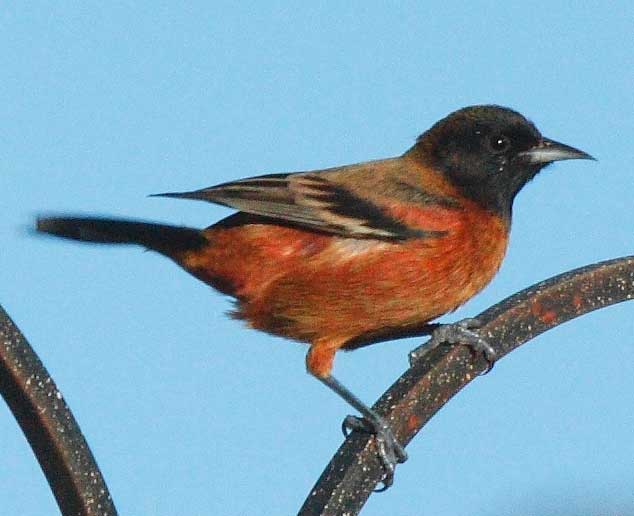
Icterus spurius, Photo: Dominic Sherony (*)
Superregnum: Eukaryota
Regnum: Animalia
Subregnum: Eumetazoa
Cladus: Bilateria
Cladus: Nephrozoa
Superphylum: Deuterostomia
Phylum: Chordata
Subphylum: Vertebrata
Infraphylum: Gnathostomata
Superclassis: Tetrapoda
Cladus: Reptiliomorpha
Cladus: Amniota
Classis: Reptilia
Cladus: Eureptilia
Cladus: Romeriida
Subclassis: Diapsida
Cladus: Sauria
Infraclassis: Archosauromorpha
Cladus: Crurotarsi
Divisio: Archosauria
Subsectio: Ornithodira
Subtaxon: Dinosauromorpha
Cladus: Dinosauria
Ordo: Saurischia
Cladus: Eusaurischia
Cladus: Theropoda
Cladus: Neotheropoda
Cladus: Averostra
Cladus: Tetanurae
Cladus: Avetheropoda
Cladus: Coelurosauria
Cladus: Maniraptoromorpha
Cladus: Maniraptoriformes
Cladus: Maniraptora
Cladus: Pennaraptora
Cladus: Eumaniraptora
Cladus: Avialae
Infraclassis: Aves
Ordo: Passeriformes
Subordo: Passeri
Infraordo: Passerida
Superfamilia: Passeroidea
Familia: Icteridae
Genus: Icterus
Species: Icterus spurius Subspecies: I. s. phillipsi - I. s. spurius
Name
Icterus spurius (Linnaeus, 1766)
References
Syst. Nat. ed.12 p. 162
Vernacular names
čeština: trupiál zahradní
dansk: Rusttrupial
Deutsch: Gartentrupial
English: Orchard Oriole
Esperanto: Hortiktero
español: Turpial Castaño, Calandria café
suomi: tarhaturpiaali
français: Oriole des vergers
Kreyòl ayisyen: Ti Mèl
magyar: kerti trupiál
italiano: Oriolo degli orti
日本語: アカクロムクドリモドキ, akakuromukudorimodoki
lkt: Škelúta číkʼala
Nederlands: Tuintroepiaal
norsk: Hagetrupial
polski: kacyk kasztanowaty
русский: Садовый трупиал
slovenčina: trupiál sadový
svenska: Trädgårdstrupial
中文: 圃拟鹂
The orchard oriole (Icterus spurius) is the smallest species of icterid. The subspecies of the Caribbean coast of Mexico, I. s. fuertesi, is sometimes considered a separate species, the ochre oriole or Fuertes's oriole.
Description
First-year male in New York City
Close view of an Orchard Oriole
Measurements:[2]
Length: 5.9-7.1 in (15-18 cm)
Weight: 0.6-1.0 oz (16-28 g)
Wingspan: 9.8 in (25 cm)
The bill is pointed and black with some blue-gray at the base of the lower mandible (Howell and Webb 1995). The adult male of the nominate subspecies has chestnut on the underparts, shoulder, and rump, with the rest of the plumage black. In the subspecies I. s. fuertesi, the chestnut is replaced with ochre (Howell and Webb 1995). The adult female and the juvenile of both subspecies have olive-green on the upper parts and yellowish on the breast and belly. All adults have pointed bills and white wing bars. (Orchard orioles are considered to be adults after their second year.) One-year-old males are yellow-greenish with a black bib.
Habitat and range
The breeding habitat is semi-open areas with deciduous trees. I. s. spurius breeds in spring across eastern North America from near the Canada–United States border south to central Mexico. A 2009 study also found breeding in the thorn forest of Baja California Sur and the coast of Sinaloa during the summer "monsoon"; this region had previously been thought to be only a migratory stopover (Rohwer, Hobson, and Rohwer, 2009). I. s. fuertesi breeds from southern Tamaulipas to Veracruz (Howell and Webb 1995). These birds enjoy living in shaded trees within parks along lakes and streams. The nest is a tightly woven pouch attached to a fork on a horizontal branch. Their nests tend to sit close together.
The nominate subspecies' winter range extends from the coastal lowlands of central Sinaloa and southern Veracruz south to northern Colombia and northwestern Venezuela (Scharf and Kren 1996). The ochre subspecies has been observed in winter on the Pacific slope of Mexico (Howell and Webb 1995).
Nominate orchard orioles depart from their winter habitats in March and April and arrive in their breeding habitats from late April to late May. Usually, they leave their breeding territories in late July and early August and arrive on their winter territories in mid August. These birds are nocturnal migrants.
Diet
While in breeding season, they eat insects and spiders. When the season changes, their diet also includes ripe fruit, which quickly passes through their digestive tract. During the winter, their diet consists of fruit, nectar, insects and seeds.
Behavior
When in flight, orchard orioles generally swoop close to the ground and fly at or below treetop level
During courtship, females display themselves in three ways. The first is by bowing their head and torso toward the male. Seesawing, the second courtship display, involves repetitively alternating lowering and raising the head and tail. The third display is begging, which is fast-paced fluttering of wings halfway extended, followed by a high whistle.
Etymology
The specific name spurius refers to the original misidentification of the male as a female Baltimore oriole. These birds are sometimes mistakenly identified as New World warblers.
References
BirdLife International (2016). "Icterus spurius". IUCN Red List of Threatened Species. 2016: e.T103793298A94850686. doi:10.2305/IUCN.UK.2016-3.RLTS.T103793298A94850686.en. Retrieved 18 November 2021.
"Orchard Oriole Identification, All About Birds, Cornell Lab of Ornithology". www.allaboutbirds.org. Retrieved 2020-09-30.
Foster, Mercedes S. (2007): The potential of fruiting trees to enhance converted habitats for migrating birds in southern Mexico. Bird Conservation International 17(1): 45–61. doi:10.1017/S0959270906000554 PDF full text
Hilty, Steven L. (2003): Birds of Venezuela. Christopher Helm, London. ISBN 0-7136-6418-5
Rohwer, Sievert, Hobson, Keith A., & Rohwer, Vanya (2009): Migratory double breeding in Neotropical migrant birds. Proceedings of the National Academy of Sciences on line. doi:10.1073/pnas.0908121106 Abstract, PDF full text (subscription required)
Scharf, William C. & Kren, Josef (1996). Orchard Oriole (Icterus spurius), The Birds of North America Online (A. Poole, Ed.). Ithaca: Cornell Lab of Ornithology; Retrieved from the Birds of North America Online: full text (subscription required)
Stiles, F. Gary & Skutch, Alexander Frank (1989): A guide to the birds of Costa Rica. Comistock, Ithaca. ISBN 0-8014-9600-4
Retrieved from "http://en.wikipedia.org/"
All text is available under the terms of the GNU Free Documentation License

